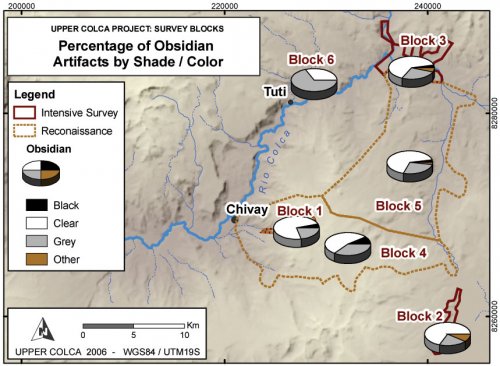(2) Obsidian from the quarry pit had more transparent coloration.
In the course of this research it was observed that there is variability in the transparency and color of culturally-modified obsidian throughout the study area and the spatial distribution is related to the appearance of natural obsidian in geological contexts. Chivay obsidian is renowned for its clarity and it is possible that material from one survey block had a greater frequency of transparency than did material from surrounding survey blocks. If clarity was a desirable characteristic of obsidian artifacts then the evidence may show a greater focus on production in areas where transparent obsidian was common. Much of the obsidian contained dark banding as well, and this banding was more visible with clear obsidian than when the obsidian matrix was a darker coloration.
Figure 6-2. Proportion of obsidian for four colors (shades) of glass, by count.
|
Black |
Clear |
Grey |
Other |
|||||
|
Block |
No. |
% |
No. |
% |
No. |
% |
No. |
% |
|
1 |
13 |
4.0 |
245 |
74.9 |
66 |
20.2 |
3.0 |
0.9 |
|
2 |
1 |
0.6 |
111 |
66.9 |
40 |
24.1 |
14.0 |
8.4 |
|
3 |
3 |
2.7 |
71 |
63.4 |
33 |
29.5 |
5.0 |
4.5 |
|
4 |
12 |
8.2 |
79 |
54.1 |
55 |
37.7 |
0.0 |
|
|
5 |
5 |
2.4 |
141 |
66.5 |
61 |
28.8 |
5.0 |
2.4 |
|
6 |
0.0 |
7 |
33.3 |
14 |
66.7 |
0.0 |
||
|
Total |
34 |
3.5 |
654 |
66.5 |
269 |
27.3 |
27.0 |
2.7 |
Table 6-7. Obsidian artifact color (shade) by survey block surface collections. Includes obsidian with bands and without bands.
As shown in Table 6-7, Block 1 indeed has a higher fraction of clear obsidian than other blocks in the survey. The high incidence of clear obsidian at Block 2 (67%) further suggests that whoever was quarrying and reducing obsidian at the A03-126 workshop in Block 1 was also associated with the settlements in Block 2, as there is no naturally occurring obsidian in Block 2. As Block 2 is on the direct transport route towards the Lake Titicaca Basin, this evidence suggests that some of the clear obsidian from Block 1 was being consumed in Block 2 en route to the larger consumption zone of the south-central Andean highland region and the Titicaca Basin where Chivay obsidian was purportedly prized for its clarity. It should be cautioned that the distinction between grey and clear obsidian appears to be correlated with thickness. That is, a "clear" artifact is more likely to be considered "grey" if it is thicker because it appears to be less transparent as a result of thickness.
